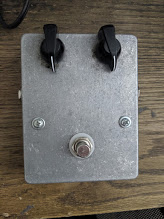

| EFFECTS PEDAL ELECTRONICS #1B ~ Basic Fuzz Pedals |
 So I'm sure people are interested in how one gets started building their own effects devices. I'm going to admit, when I started, I already had a background in the electronics from inside electric guitars - which I suggest reading here first because this is a good tutorial on general guitar electronics stuff, and it's a lot easier, and less expensive to start experimenting with. So I'm sure people are interested in how one gets started building their own effects devices. I'm going to admit, when I started, I already had a background in the electronics from inside electric guitars - which I suggest reading here first because this is a good tutorial on general guitar electronics stuff, and it's a lot easier, and less expensive to start experimenting with.
NOTE: I lay no claim to being an "electronics expert", what you do is at your own risk, and I may get some stuff wrong here and there. I'm still learning, this page just shares what/how I learned how to do this stuff. So long story short, I got into this because I was in a 90's cover band at the time and I wanted a more "90's guitar sound" to go with my rig. When I saw the prices on Fuzz Devices in the style that I liked they were insanely expensive. And that expense became really silly in my eyes when I found out how simple a Fuzz Pedal actually is to make - a basic one. So I probably did the stupidest, most impulsive thing one could do with my kind of skills - bought $90 of parts with birthday money from Vetco and went about designing my own fuzz. No, we are not going to study the "Fazz Fuzz" here, we're going to study more simple designs.BASIC LAYOUT OF A FUZZ CIRCUIT A Basic Fuzz Circuit can be broken down into the "power circuit", "Switching" circuit, the "Core Fuzz" circuit, and the "Tone" Circuit. SWitching Circuit - Following the signal path, the guitar's output goes to the input jack on the Fuzz, this then feeds into a DPDT or 3PDT footswitch. When in the off position, the signal is fed through the wire on the bottom, and then fed out the other side to the output jack - bypassing the circuit. The ground stays present through the whole circuit. This is actually a universal principle to all effects pedals actually (and there are more sophisticated means using a momentary pushbutton and a hardware switching IC but that's too advanced for this page). On a 3PDT switch, the center lugs in the example are used to turn the LED light on and off...mostly by deriving power from the power circuit positive lead, and then feeding it through the LED bulb to ground. Core Fuzz Circuit - This circuit consists of a BC547 NPN transistor - same as I used in the "SkullFuzz" circuit. The core of the fuzz circuit consists of a input capacitor, one or two diodes, and a transistor. The "Emitter" goes off to ground, or can be used to control gain through "bias". the base - middle lead - is used for output, while the collector is used for input. The Emitter and Base on a basic fuzz have one or two diodes wired up between them, and when there's two diodes, they go in opposite directions of each other. People use all kinds of things for Diodes in fuzzes and they can make a difference in sound. Where I'm at skill-wise right now, it's all about experimentation. When the fuzz is switched on, the guitar signal is fed into the transistor with the power signal into the collector. The Clipping diodes induce clipping (the actual fuzz/distortion in the circuit), and then the output is fed through the base and out to the tone circuit, level, and output jack. Power Circuit - The power circuit is one of the most critical elements of a fuzz circuit. In most cases, you can't simply plop on a 9 volt battery and expect the thing to sound great. If you have used a Fuzz pedal before, you've probably noticed how the bloody thing - even a fancy one like a Fuzz Factory - takes bloody FOREVER to run out of juice. That's because Fuzz Pedals don't really need all 9-volts of electricity. Typically, if there's too much power, the fuzz will become "Gated", not as distorted, and very bassy, sounding more like a video game noise, while if the fuzz has too little power, it won't make any sound at all. My SKullfuzz's sweetspot for general use is around 3vdc. I got around this on the FazzFuzz by making a huge pedal with 5 transistors and a whole bunch of other stuff to suck up the power beforehand. The power circuit is fed into the collector of the transistor. Tone Circuit - Lastly is the tone circuit. This allows you to control the overall tone of the pedal, and is optional. My Skullfuzz does not have one. Usually this part also may involve using a volume pot at the end to control the output volume to balance with other pedals. Most people when they make effects pedals like this, they just use a regular guitar tone control wired into the pedal. This would be a basic potentiometer with a capacitor either feeding into the center lug, or grounded off on the rightmost lug facing the bottom of the pot. Actually, almost any standard guitar tone control works. |